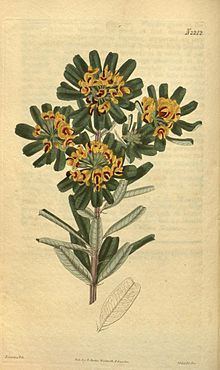Rank Species | ||
 | ||
Similar Gastrolobium, Gastrolobium coriaceum, Gastrolobium praemorsum, Gastrolobium celsianum, Gastrolobium sericeum | ||
Gastrolobium bilobum, commonly known as heart-leaved poison, is a bushy shrub which is endemic to south west Western Australia.
The species is a member of the family Fabaceae and is probably the most toxic species in the genus Gastrolobium, containing high levels of monofluroacetic acid
The species grows to a height of up to 4 metres. Between late winter and early summer (August to December in Australia) it produces yellow-orange pea-flowers with a central yellow area encircled by a band of red, and a maroon keel. The leaves are cuneiform, obovate or elliptic.
The species was first formally described by botanist Robert Brown and published in Hortus Kew in 1811
In the nineteenth century as a plant within the group of gastrolobium, it was written about in the local press this continued into the early and mid twentieth century, due to the affects on agriculture
It has been further analyzed within the Australian Nucleotide and Protein sequencing
The vernacular name has been common for over 140 years, and is inappropriate due the leaves being wedge shaped, not heart shaped as the name suggests.
It occurs in the south-west of the state, usually on granite-based soils on peaks and outcrops as well as along rivers. It is associated with karri and marri forest as well as mallee and heathland.
